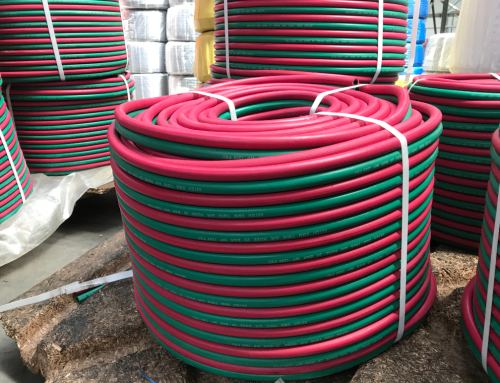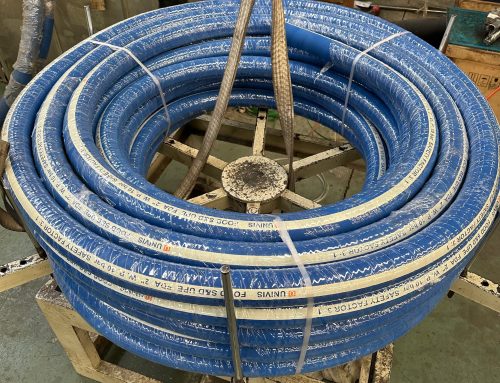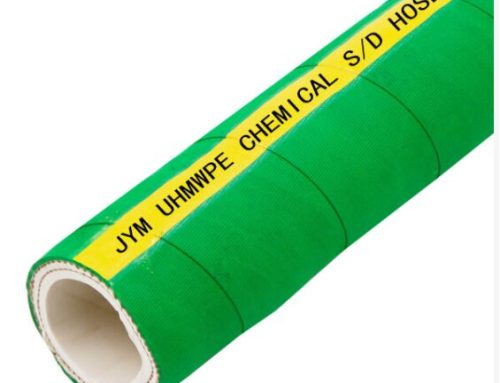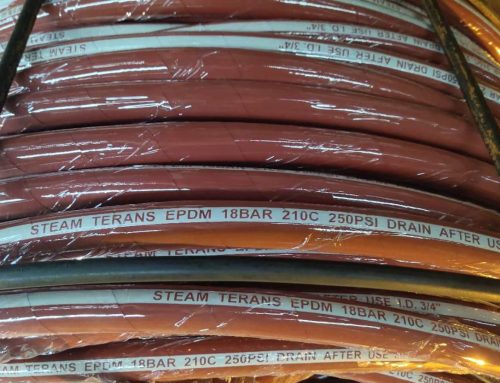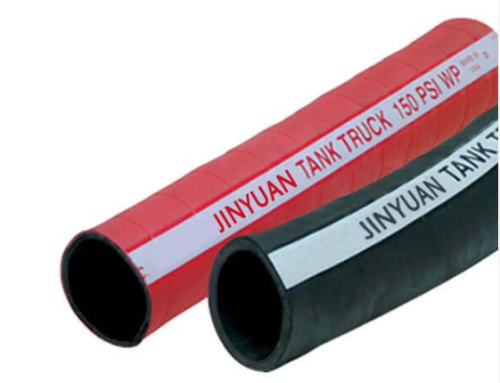High Pressure Hose also called high pressure rubber hose. It can be divided into air compressor hose, sandblast hose, spray hose(Garden & Agricultural hose). It is used in mine hydraulic support, engineering construction, lifting and transportation, metallurgical forging, mining equipment, ships, injection molding machinery, agricultural machinery, various machine tools, and mechanical and automated hydraulic systems in various industrial sectors.
According to the manufacturing process, the high-pressure rubber hose is mainly divided into a high-pressure steel wire braided hose and a high-pressure steel wire wound hose.
Wire wound hose
The high-pressure steel wire wound hose structure is mainly composed of an inner rubber layer, a middle rubber layer, four or more layers of steel wire reinforcing layer and outer rubber layer which are alternately wound.
The inner rubber layer has the function of subjecting the conveying medium to pressure and protecting the steel wire from erosion. The outer rubber layer protects the steel wire from damage, and the steel wire layer is a reinforcing material for the skeleton material.
High-pressure steel wire wound tubing (high-pressure tubing) Uses: High-pressure steel wire reinforced hydraulic tubing is mainly used for mine hydraulic support and oilfield development, suitable for engineering construction, lifting and transportation, metallurgical forging, mining equipment, ships, injection molding machinery, agricultural machinery, various Machine tools and mechanical and automated hydraulic systems in various industrial sectors deliver water-based liquids (such as emulsions) with a certain pressure (higher pressure) and temperature. The highest working pressure can reach 70-120Mpa.
High-pressure steel wire wound tubing (high pressure tubing) working temperature: -40℃—120℃
Product specifications range: DN6mm ~ DN305mm.
Type:
4SP type – four-layer steel wire wrapped medium pressure hose.
4SH type – four-layer steel wire wound high pressure hose.
R12 type – four layers of steel wire wound high temperature medium pressure oil pipe under severe conditions.
R13 type – multi-layer steel wire wound high temperature and high pressure oil pipe under severe conditions.
R15 type – multi-layer steel wire wound high temperature ultra high pressure oil pipe under severe conditions.
Steel wire braided hose
The high-pressure steel wire braided hose structure is mainly composed of a liquid-resistant synthetic rubber inner rubber layer, a middle rubber layer, an I, II, and III steel wire braid layer, and a weather resistant synthetic rubber outer rubber layer.
However, according to the design principle of the high-pressure hose, the III-layer braided hose does not have any effect when the hose is under pressure, wastes the material in vain, increases the weight of the hose itself, and reduces the flexibility of the hose. Therefore, there is no such standard for hoses in national standards. Older engineers in some companies still use the old standards of the past, so some people still choose this model when designing.
High-pressure steel wire braided hose Use: High-pressure steel wire reinforced hydraulic oil pipe is mainly used for mine hydraulic support and oilfield development, suitable for engineering construction, lifting and transportation, metallurgical forging, mining equipment, ships, injection molding machinery, agricultural machinery, various machine tools and various industries. The department mechanized and automated hydraulic system delivers petroleum-based (such as mineral oil, soluble oil, hydraulic oil, fuel oil, lubricating oil) and water-based liquid (such as emulsion, oil-water emulsion, water) with a certain pressure and temperature. Liquid drive.
High-pressure steel wire braided hose working temperature: oil -40 ° C ~ 100 ° C, air -30 ° C ~ 50 ° C, water emulsion + 80 ° C below.
High-pressure steel wire braided hose specifications range: DN5mm ~ DN102mm.
The compressed air tube is a chemical with appearance, softness, oxidation resistance, anti-aging, and full-text irritancy.
Air compressed hoses are commonly used in compressed air, auto parts shops and pneumatic (air pressure) tools, as well as water and non-corrosive liquids, and are widely used in industries, construction, agriculture and other fields. The soft-walled air compression tube has the appearance, softness, elasticity similar to rubber, anti-oxidation, anti-aging, summer is not soft, winter is not hard, no cracking characteristics.
Sandblasting hose is also called a rubber hose for sand and grit blasting. It is suitable for sandblasting rubber hoses for wind-blasting, rust-removing, numbing and wet blasting and dry blasting in metal construction. It is suitable for sandblasting rubber hoses for wind-blasting, rust-removing, numbing and wet blasting and dry blasting in metal construction.
Common areas of application are shipbuilding, machining, and painting industries.
Type A electrically connected, marked “M” level;
Type B has a conductive rubber layer and is marked “Ω” grade;
Type C Non-conducting ordinary type, marked “A” level;
Operating temperature: The hose is used at a temperature of -20-70 °C.
The blasting pipe shall have the following components:
– inner liner (inner layer);
– a reinforcing layer of natural or synthetic fabric laid in a suitable manner;
– outer cover (outer glue layer);
Among them, the reinforced layer method and the cord winding method are often used.
Hydraulic requirements
- The working pressure of the hose is up to 0.63 MPa.
- When the hose is subjected to hydraulic test under twice working pressure, it should not seep water, no local bulging, no expansion and no other abnormal phenomena. The anti static hose should be kept at a pressure of 1 min, its length should not exceed ±0.8%, the outer diameter should not exceed ±10%, and no twist should not exceed 60º
- The hose pressure is not less than 4 times the working pressure.
Bending performance
At 23℃, when the hose is tested with a minimum bend radius of 10 times the nominal inner diameter, the deformation KD value should not exceed 0.8 times the outer diameter D of the hose. (K is the outer diameter of the hose before bending and the ratio of the outer diameter after bending to the outer diameter before bending.)
(-25 ± 2 ℃), there should be no cracking after bending.
As the main performance of the sandblasting hose, it is also the main basis for the user to distinguish the quality of the hose. According to the current industry standard HG/T2192-2008, according to method A of ISO 4649, the wear volume does not exceed 140 mm & sup3; (The test method used in the previous version of the industry standard is: Acron wear method – wear volume does not exceed 0.8cm & sup3; / 1.61km. This method has been replaced by ISO 4649 Method A after 2008, but some domestic This method of measurement is still used by the hose user.)
Other properties such as: Inter layer adhesion strength, ozone resistance, mechanical properties under verification pressure are also indicators for considering the quality of sandblasting tubes. For details, please refer to the industry standard HG/T2192-2008 of China’s current sandblasting tubes.
Spray hose can be used in conveying water or other liquid environments. Hoses are used to carry fluids through air or fluid environments, and they are typically used with clamps, spigots, flanges, and nozzles to control fluid flow. A garden hose or an agricultural hose is used to water plants in a garden or lawn, or to convey water to a sprinkler for the same purpose.

